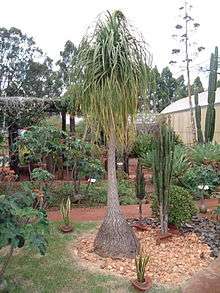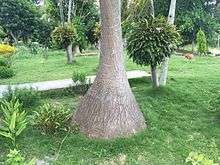Beaucarnea recurvata
| Beaucarnea recurvata | |
|---|---|
 | |
| Scientific classification | |
| Kingdom: | Plantae |
| Clade: | Angiosperms |
| Clade: | Monocots |
| Order: | Asparagales |
| Family: | Asparagaceae |
| Subfamily: | Nolinoideae |
| Genus: | Beaucarnea |
| Species: | B. recurvata |
| Binomial name | |
| Beaucarnea recurvata | |
| Synonyms[1] | |
| |
Beaucarnea recurvata (elephant's foot, ponytail palm) is a species of plant in the family Asparagaceae, native to the states of Tamaulipas, Veracruz and San Luis Potosí in eastern Mexico.[2] Despite its common name, it is not closely related to the true palms (Arecaceae). It has become popular in Europe and worldwide as an ornamental plant. There are 350-year-old Beaucarneas registered in Mexico.[3]
Description
It is an evergreen perennial growing to 15 feet 6.34 inches (4.7330 m) with a noticeable expanded caudex, for storing water. The single palm-like stem produces terminal tufts of strap-shaped, recurved leathery leaves, sometimes hair lock-shaped in the ends, and with occasional panicles of small white flowers once the plant reaches over 10 years of age. There are 10 different species of this plant, according to the Institute of Ecology in Xalapa, state of Veracruz, which runs the Jardín Botánico Francisco Javier Clavijero botanical garden, where over 400 Beaucarneas are exhibited and more are grown in greenhouses for conservation purposes, in the "Colección Nacional de Beaucarneas" (Beaucarneas National Collection).[4]
Cultivation

Having gained the Royal Horticultural Society's Award of Garden Merit.[5] B. recurvata is often grown as a houseplant or an outdoor plant in temperate climate gardens. Slow-growing and drought-tolerant, Beaucarnea recurvata is hardy to −5 °C (23 °F), grows in full sun to light shade, and requires proper soil mix to drain when watered. However, be cautious not to over-water, as this will foster pests like the mealybug and cochineal insect. If going to be kept in places with strong winters, it must be an indoor plant as it cannot resist cold temperatures. To maintain its original shape, the ends of its leaves should not be snipped, and when repotted it must keep all of its roots.
State of conservation
The species of the genus Beaucarnea are mostly in critical condition, this due to the various anthropogenic activities, which has led to severe fragmentation and destruction of their habitat. On the other hand, the extraction of seeds, seedlings, juveniles and adults have affected the size of the population and the proportion of sexes, reducing with this the possibilities of fertilization and, consequently, the production of seeds.[6] This exploitation process exposes this species, in a state of threat or extinction, by reducing the minimum viable size of the populations, as well as the deterioration of their genetic diversity.[7] B. recurvata, is considered to be threatened according to Official Mexican Standard 059-ECOL-2010 of SEMARNAT in Mexico.
References
- ↑ "The Plant List: A Working List of All Plant Species". Retrieved May 16, 2014.
- ↑ Irish, Gary (2000). Agaves, Yuccas, and Related Plants: A Gardener's Guide. Timber Press. p. 187. ISBN 978-0-88192-442-8.
- ↑ Instituto de Ecología A.C. video files, Mexico
- ↑ http://hdl.handle.net/10045/8837 Armando Contreras, María Luisa Osorio, Miguel Equihua et al. (2008) Conservación y Aprovechamiento de Beaucarnea recurvata, Especie Forestal no Maderable, 7. In Cuadernos de Biodiversidad.
- ↑ "RHS Plant Selector - Beaucarnea recurvata". Retrieved 27 June 2013.
- ↑ Hernández SL, M. Martínez, G. Malda B., HA Castillo G., O. Salcedo G., Osorio R. Ma. L., A. Contreras H., R. Orellana L., C. Swords M., LE Carrillo S., KKE Almanza R., M. Capdevielle V, Ml Á. Herrera A. and M. Á. Pérez F. 2010. Final project report (ORN_PTA 09). Collection of elephant foot accessions ( Beaucarnea spp .) For germplasm conservation in Mexico . Autonomous University of Queretaro. 54 p.
- ↑ Nason, J, and JL Hamrick. 1997. Reproductive and genetic consequences of forest fragmentation: two case studies of Neotropical canopy trees. Journal of Heredity. 88 (4): 264-276.
External links
- "Beaucarnea recurvata". Germplasm Resources Information Network (GRIN). Agricultural Research Service (ARS), United States Department of Agriculture (USDA).
 A Ponytail Palm growing outdoors at Disney's Animal Kingdom, Florida.
A Ponytail Palm growing outdoors at Disney's Animal Kingdom, Florida.- Beaucarnea recurvata in Madeira garden.
 Beaucarnea recurvata in Parrot Jungle, Miami
Beaucarnea recurvata in Parrot Jungle, Miami A small Ponytail Palm in Homestead, Florida.
A small Ponytail Palm in Homestead, Florida. Regrowth after a crown breakage, in Homestead, Florida
Regrowth after a crown breakage, in Homestead, Florida